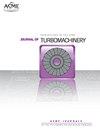跨声速尖叫器尖部冷却与高速相对机匣运动的相互作用机理
IF 3.1
3区 工程技术
Q3 ENGINEERING, MECHANICAL
引用次数: 0
摘要
机匣相对运动对涡轮叶顶气动热性能有重要影响。本文在新研制的高速盘式转子装置上进行了实验研究,该装置可以模拟发动机真实的高速机匣相对运动,同时可以实现对跨声速涡轮叶尖表面的全光学成像。利用红外瞬态热测量技术,获得了冷却后的跨声速尖叫尖顶的空间分辨传热数据,包括传热系数和气膜冷却效率。结合紧密耦合的reynolds -average Navier-Stokes计算流体动力学(CFD)分析,揭示了在有或没有套管相对运动影响的情况下,压力侧冷却注入与空腔底板之间有趣的相互作用机制。实验数据和CFD计算结果都显示了传热和冷却性能的一致趋势。当仅采用空腔冷却时,冷却性能受机匣相对运动的影响而降低。然而,通过从压力侧注入额外的冷却,可以观察到冷却性能与相对套管运动的显著改善。这种相反的趋势在对不同的尖端冷却设计进行排序时突出了相对机匣运动的重要性。考虑到机匣的相对运动,从两个不同位置联合注入冷却可以获得额外的冷却效果。本文章由计算机程序翻译,如有差异,请以英文原文为准。
Interaction Mechanism of Transonic Squealer Tip Cooling With the Effect of High-Speed Relative Casing Motion
Abstract The relative casing motion can significantly influence the turbine blade tip aerothermal performance. In this study, experimental investigation was conducted in a newly developed high-speed disk rotor rig which can mimic engine realistic high-speed casing relative motion while enabling full optical access to a transonic turbine blade tip surface. Spatially-resolved tip heat transfer data, including heat transfer coefficient and film cooling effectiveness, were obtained for a cooled transonic squealer tip by infrared transient thermal measurement. Combined with closely coupled Reynolds-averaged Navier–Stokes computational fluid dynamics (CFD) analysis, this paper reveals an interesting interaction mechanism between the cooling injections from the pressure side and the cavity floor with and without the effect of relative casing motion. Both experimental data and CFD results show a consistent trend in both heat transfer and cooling performance. With cavity cooling only, the cooling performance reduces with the effect of relative casing motion. However, with additional cooling injection from the pressure side, a significant improvement in the combined cooling performance with the relative casing motion can be observed. Such opposite trend highlights the importance of relative casing motion when ranking different tip cooling designs. With the consideration of relative casing motion, extra tip cooling benefit can be obtained by combining cooling injections from two different locations.
求助全文
通过发布文献求助,成功后即可免费获取论文全文。
去求助
来源期刊
CiteScore
4.70
自引率
11.80%
发文量
168
审稿时长
9 months
期刊介绍:
The Journal of Turbomachinery publishes archival-quality, peer-reviewed technical papers that advance the state-of-the-art of turbomachinery technology related to gas turbine engines. The broad scope of the subject matter includes the fluid dynamics, heat transfer, and aeromechanics technology associated with the design, analysis, modeling, testing, and performance of turbomachinery. Emphasis is placed on gas-path technologies associated with axial compressors, centrifugal compressors, and turbines.
Topics: Aerodynamic design, analysis, and test of compressor and turbine blading; Compressor stall, surge, and operability issues; Heat transfer phenomena and film cooling design, analysis, and testing in turbines; Aeromechanical instabilities; Computational fluid dynamics (CFD) applied to turbomachinery, boundary layer development, measurement techniques, and cavity and leaking flows.

 求助内容:
求助内容: 应助结果提醒方式:
应助结果提醒方式:


